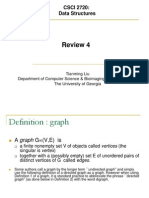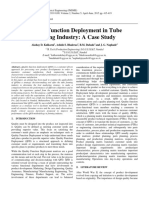NPTEL MOOC,JAN-FEB 2015
Week 4, Module 6
DESIGN AND ANALYSIS
OF ALGORITHMS
Spanning trees: Prim’s algorithm
MADHAVAN MUKUND, CHENNAI MATHEMATICAL INSTITUTE
http://www.cmi.ac.in/~madhavan
Spanning tree
Weighted undirected graph, G = (V,E,w)
Assume G is connected
Identify a spanning tree with minimum weight
Tree connecting all vertices in V
Strategy 1:
Start with minimum cost edge
Keep extending the tree with smallest edge
Prim’s algorithm
algorithm Prim_V1
Let e = (i,j) be minimum cost edge in E
TE = [e] //List of edges in tree
TV = [i,j] //List of vertices connected by tree
for i = 3 to n
choose edge f = (u,v) of minimum cost
such that u in TV and v not in TV
TE.append(f)
TV.append(v)
return(TE)
Correctness
Prim’s algorithm is a greedy algorithm
Like Dijkstra’s single source shortest path
A local heuristic is used to decide which edge to
add next to the tree
Choices made are never reconsidered
Why does this sequence of local choices achieve
a global optimum?
Minimum separator lemma
Let V be partitioned into two non-empty sets U
and W = V - U
Let e = (u,w) be minimum cost edge with u in U
and w in W
Assume all edges have different weights (relax
this condition later)
Then every minimum cost spanning tree must
include e
Minimum separator lemma
Let T be a minimum cost
spanning tree, e = (u,w) not in T
u in U and w in W are
connected by a path p in T
p starts in U and ends in W
Let f = (u’,w’) be the first
edge on p such that u’ in U
and w’ in W
Drop f and add e to get a
smaller spanning tree
Minimum separator lemma
Let T be a minimum cost
spanning tree, e = (u,w) not in T
u in U and w in W are
connected by a path p in T u v
p starts in U and ends in W
Let f = (u’,w’) be the first
edge on p such that u’ in U
and w’ in W
Drop f and add e to get a
smaller spanning tree
Minimum separator lemma
Let T be a minimum cost
spanning tree, e = (u,w) not in T
u in U and w in W are
connected by a path p in T u v
p starts in U and ends in W
u’ v’
Let f = (u’,w’) be the first
edge on p such that u’ in U
and w’ in W
Drop f and add e to get a
smaller spanning tree
Minimum separator lemma
Proof of the lemma is
slightly subtle
u v
Not enough to replace
any edge from U to W by
e = (u,v) u’ v’
Need to identify such an u’’
edge on the path from u v”
to v
Correctness of Prim’s
algorithm
Correctness follows directly from minimum
separator lemma
At each stage, TV and (V-TV) form a non-trivial
partition of V
The smallest edge connecting TV to (V-TV) must
belong to every minimum cost spanning tree
This is the edge that the algorithm picks
Further observations
Need not start with smallest edge overall
For any vertex v, smallest edge attached to v
must be in the minimum cost spanning tree
Consider the partition {v}, V-{v}
Can start with any such edge
Prim’s algorithm revisited
Start with TV = {s} for any vertex s
For each vertex v outside TV, maintain
Distance_TV(v), smallest edge weight from v to TV
Neighbour_TV(v), nearest neighbour of v in TV
At each stage, add to TV (“burn”) vertex u with smallest
Distance_TV(u)
Update Distance_TV(v), Neighbour_TV(v) for each
neighbour of u
Very similar to Dijkstra’s algorithm!
Prim’s algorithm, refined
function Prim
for i = 1 to n
visited[i] = False; Nbr_TV[i] = -1; Dist_TV[i] = infinity
TE = [] //List of spanning tree edges
visited[1] = True
for each edge (1,j)
Nbr_TV[j] = 1; Dist_TV[j] = weight(1,j)
for i = 2 to n
Choose u such that Visited[u] == False
and Dist_TV[u] is minimum
Visited[u] = True
TE.append{(u,Nbr_TV[u])}
for each edge (u,v) with Visited[v] == False
if Dist_TV[v] > weight(u,v)
Dist_TV[v] = weight(u,v); Nbr_TV[i] = u
Prim’s algorithm
70
3 4
18 6
10
1 2 5 6
10 20
10 5
7
Prim’s algorithm
70
3 4
18 6
10
1 2 5 6
10 20
10 5
7
Prim’s algorithm
(18,1)
70
3 4
18 6
10
1 2 5 6
10 20
10 5
7
Prim’s algorithm
(18,1)
70
3 4
18 6
10
1 2 5 6
10 20
(10,1)
10 5
7
Prim’s algorithm
(18,1)
70
3 4
18 6
10
1 2 5 6
10 20
10 5
7
Prim’s algorithm
(6,2)
70
3 4
18 6
10
1 2 5 6
10 20
10 5
7
Prim’s algorithm
(6,2)
70
3 4
18 6 (20,2)
10
1 2 5 6
10 20
10 5
7
Prim’s algorithm
70
3 4
18 6 (20,2)
10
1 2 5 6
10 20
10 5
7
Prim’s algorithm
(70,3)
70
3 4
18 6 (20,2)
10
1 2 5 6
10 20
10 5
7
Prim’s algorithm
(70,3)
70
3 4
18 6
10
1 2 5 6
10 20
10 5
7
Prim’s algorithm
(70,3)
70
3 4
18 6 (10,5)
10
1 2 5 6
10 20
10 5
7
Prim’s algorithm
(70,3)
70
3 4
18 6 (10,5)
10
1 2 5 6
10 20
10 5
7
(10,5)
Prim’s algorithm
(70,3)
70
3 4
18 6 (10,5)
10
1 2 5 6
10 20
10 5
7
Prim’s algorithm
(70,3)
70
3 4
18 6 (5,7)
10
1 2 5 6
10 20
10 5
7
Prim’s algorithm
(70,3)
70
3 4
18 6
10
1 2 5 6
10 20
10 5
7
Prim’s algorithm
70
3 4
18 6
10
1 2 5 6
10 20
10 5
7
Complexity
Similar to Dijkstra’s algorithm
Outer loop runs n times
In each iteration, we add one vertex to the tree
O(n) scan to find nearest vertex to add
Each time we add a vertex v, we have to scan all its
neighbours to update distances
O(n) scan of adjacency matrix to find all neighbours
2
Overall O(n )
Complexity
Moving from adjacency matrix to adjacency list
Across n iterations, O(m) to update neighbours
Maintain distance information in a heap
Finding minimum and updating is O(log n)
Overall O(n log n + m log n) = O((m+n) log n)
Minimum separator lemma
We assumed edge weights are distinct
Duplicate edge weights?
Fix an overall ordering {1,2,…,m} of edges
Edge e = ((u,v),i) is smaller than f = ((u’,v’),j) if
weight(e) < weight(f)
weight(e) = weight(f) and i < j
Multiple spanning trees
If edge weights repeat, the minimum cost spanning
tree is not unique
“Choose u such that Dist_TV(u) is minimum”
Different choices generate different trees
Different ways of ordering edges {1,2,…,m}
In general, number of possible minimum cost
spanning trees is exponential
Greedy algorithm efficiently picks out one of them


























































































